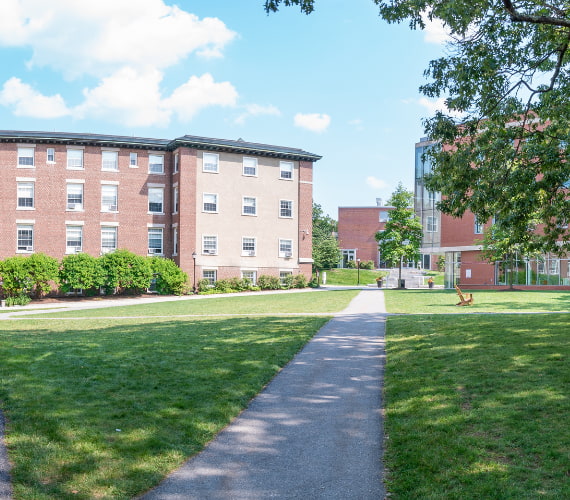The college search process can seem daunting at first. There are many colleges and universities across the United States and worldwide, each with unique offerings. Choosing the right school requires researching multiple programs, visiting campuses, completing the application process, and reviewing your offers.
The admission timeline ideally begins your junior year, however, for those with a late start there’s still plenty of time to accomplish all of the tasks ahead.
With the professional advice of Regis College’s Director of Admission, Alex Patturelli, and the Guide to Applying to College you can tackle the admission process with confidence. Here’s a closer look at the essential steps you’ll need to consider when applying to college and how they work into your application timeline.
1. Find the Right School
Finding the right school for you isn’t as simple as picking the closest university to you, or going to your parents’ alma mater. It requires research and narrowing down your search according to your personal and professional aspirations.
Building Your College List
Each student should identify a variety of schools that meet their wants and needs with varying degrees of likelihood for admission. To begin, you must identify what your wants and needs are, which is dependent on a number of factors, including:
- Location: Specific states, regions, or proximity to home that you’re interested in
- Type of School: The level of education you would like to pursue as well as whether you want to attend an institution with special missions, including historically Black colleges and universities, all-women or all-men universities, religious programs, and more; or if you’re interested in public or private. Remember don’t limit yourself, both public and private colleges can be affordable with financial aid.
- Academic Offerings: Narrow your school search down according to academic offerings such as majors, minors, and robust exploratory options for undecided students to help identify professional interests
- Campus Life: Factors like campus size, setting (urban, suburban, or rural) can significantly narrow down your options. Student life and activities, including; varsity and intramural athletics, clubs, and organizations, as well as, student support services.
- Cost: The cost of tuition, fees, and room and board (if applicable), as well as financial aid opportunities available (grants and aid, scholarships, payment plans, and more)
Websites like the College Board, Peterson’s, and the Princeton Review are free online resources with interactive college searches. Depending on your selected filters, these searches can yield hundreds of results or only a handful.
As you narrow down the list of schools you’re interested in, it’s important to consider your admissibility as well. For those schools you’d like to consider further, you should make note of their average admitted student profile which may include:
- Grade Point Average (GPA): The cumulative grade point average for all years of high school is typically a number on a 4.0 scale. However, it’s common for admission offices to recalculate your GPA utilizing their grading scale, which usually awards students who have taken honors/AP/IB courses when available.
- High School Rank: A student’s rank within their graduating class, if provided by the high school.
- Standardized Test Scores: The average SAT and/or ACT scores, if required by the institution.
- Acceptance Rate: The rate of total applicants versus those admitted.
Students are typically advised to apply to schools where they are below, average, and above the admitted student profile, often referred to as Reach, Target, or Safety schools. “This rating system allows you to have realistic expectations about your chances of getting into school, but I wouldn’t let it be the only factor. If you feel at home at a safety school, don’t push yourself to go to a reach school just for the prestige,” says Patturelli. Finding the right fit for you requires time, research, and campus visits when possible.
Narrowing Your College List
Once you have identified an initial list of schools that meet your criteria and align with your likelihood for admission, you must narrow it down further. Visiting colleges and universities is the next step to finalizing your college list. Visits are critical to envisioning if you could live and learn at each school over the next few years. Start by looking at the visit opportunities at each college (e.g., information sessions, campus tours, open house events, college interviews), and pick the ones that will shed the most light on topics you’re interested in (e.g., student life, residence halls, student support resources).
Daily visits, such as information sessions, campus tours, and college interviews, are offered throughout the year. These visits allow you to see the campus, ask questions to staff and students, and get to know the school on a more personal level.
Special events, such as open houses, are more comprehensive and include academic presentations, fairs to meet faculty, and much more. While online presentations and experiences offer the opportunity to learn more at your convenience from home.
Visiting the campus is one way to begin experiencing what it would be like to be a student, but another way is engaging with members of the campus community. Emailing admission staff or faculty, for instance, allows you to ask questions and get to know the people who make up the institution. Participating in live chats, social media, and online groups are a great way to chat with current students, alumni, parents of current students and more. All of these events and resources provide more insight into whether a school is the right fit for you.
2. Know Your Deadlines
After finalizing your college list you need to plan for a variety of admission deadlines. Application deadlines differ by college and can be as early as October of your senior year or as late as mid-spring.
It’s often recommended that students apply early, “the earlier the better,” says Patturelli. By applying early you’ll likely receive your decision earlier and have the best opportunities for scholarships and merit aid. Additionally, applying early “gives students the most amount of time to compare options before making a decision,” says Patturelli.
Most applications open on an annual basis starting August 1. While most schools require similar application requirements, how and when to apply can differ. Here’s a closer look at what these application deadline options are and how they affect your admission timeline.
Early Decision I and II
Early decision refers to applications that are submitted in the fall. These deadlines are typically in early to mid-November. Before applying under this option, it’s important to note that early decision is a binding agreement to enroll. This means that if you are admitted, you must submit your deposit, withdraw other college applications, and commit to attending. You should only plan to apply early decision if you are set on attending that school.
An important caveat of early decision worth considering is entering this agreement without seeing a financial aid offer. While a benefit of early decision is giving some students a better chance of getting into a school, students and their parents/guardians need to be prepared for the cost. In addition, if you choose to apply early decision, you can only do so for one college.
Early Action I and II
Early action allows a student to apply and receive an admission decision early. Unlike early decision, however, this is a non-binding option. Early action deadlines are typically mid- to late November, followed by a decision in December. This admission option allows students to receive a decision early in the cycle with a deadline to deposit by May 1.
Regular Decision
Regular admission deadlines, often the most popular, fall in January or February of a student’s senior year. Decisions for regular admission applicants are released in March or April with a deadline to deposit by May 1. Regular decision deadlines give students the most amount of time to prepare their application, but the least amount of time to consider their options after getting their decision.
Rolling Admission
The rolling admission process entails application submissions on an on-going basis. This means the admission offices evaluate those applications as they are submitted. In general, there are multiple recommended deadlines throughout the rolling admission process, but colleges will continue issuing decisions until all spots in their class are filled.
3. Submit Your Application
Colleges across the country utilize a variety of applications. The most commonly used system is the Common Application, but there are additional application resources, including the Coalition Application and systems unique to each school’s website.
Despite differing deadlines or methods from school to school, your application requirements will overlap. The most common application requirements include:
- A completed application
- High School Transcript: Request through your college/school counseling office
- Letter(s) of Recommendation: Often completed by your school counselor, teachers, and coaches/supervisors/advisors
- Test Scores: Standardized tests, such as the ACT or SAT, are required of many institutions, but some colleges and universities, like Regis College, have a test optional policy. Students should only submit test scores to these optional programs when they feel it enhances their application.
- College Essay: An opportunity to express yourself in a narrative with either a provided prompt or your topic of choice
- High School Resume: An important part of your application that provides context to the activities, interests, and experiences you’ve participated in
- Application Fee: These are set by each school and should be discussed with a parent/guardian and school counselor before applying. Institutions may offer application fee waivers for those with a demonstrated need, or for attendance at particular events, but there are schools, like Regis College, that don’t have an application fee at all.
Applying for Financial Aid
In addition to your admission application it’s equally important to plan for your financial aid applications. For those in need of financial assistance, you must plan for the required application, documentation, and deadlines. Many institutions require students to fill out the Free Application for Federal Student Aid (FAFSA) or the more comprehensive CSS Profile during the college application process. “If you can't afford to go to school out-of-pocket, you need to plan and submit your financial aid application as quickly as possible to be able to make the right financial decision when you choose a school,” says Patturelli.
Admission Decisions and Next Steps
Upon reviewing your application, admission offices may release a variety of admission decisions. These decisions include acceptance, deferral (more information is requested in order to issue your decision), waitlist (your decision will be released later in the admission cycle upon reviewing other applications), and denial.
While this waiting can be difficult at times, it’s critical that while you await your admission decision you remain engaged and interested in the school. Attending admitted student events, requesting interviews, or joining webinars all continue to demonstrate your interest. These events are also resources for you to learn more and assess your options.
Your college application process culminates on May 1, also known as National Decision Day. This is the day you finally submit your acceptance and make a deposit to attend the college or university of your choice. After all your hard work, you’ll be one step closer to pursuing your passions at a school that’s right for you.




